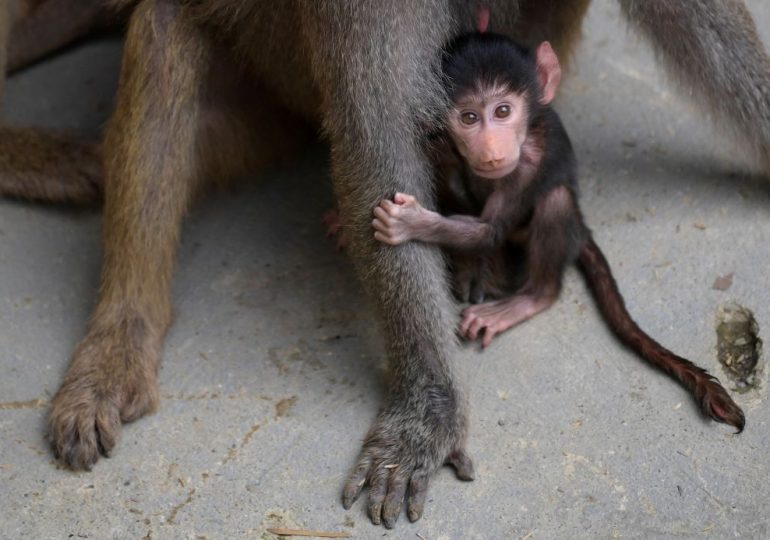My closest brush with motherhood was an intense 24 hours fostering an orphaned baby owl monkey in the Peruvian Amazon in 2009. According to Charles Darwin, my maternal drive should have transformed me into an intuitively wise and selfless nurse. But the truth was I felt quite traumatized—fretful, exhausted, and for the sake of my defiled and defecated hair alone (the baby was happiest when clinging to my head), uninclined to repeat the ordeal ever again. I was 39 at the time and wrestling with whether I should be having children myself. My night with the owl monkey reinforced my suspicion that I was not cut out for motherhood.
[time-brightcove not-tgx=”true”]
Females have long been equated with motherhood, as if no other role existed. But my research about motherhood in the animal kingdom taught me that maternal instinct is a long-standing myth, created by men, that reduces females to identikit automatons and belittles the complexities of motherhood.
Firstly, maternal instinct assumes caring for young is the sole responsibility of the female. In the owl monkey’s case, his mother would have suckled him every few hours. But after each feeding she would have driven him away, quite unsentimentally, by biting his tail, leaving his father to take on the heavy job of carrying him 90% of the time.
The commitment to childcare demonstrated by owl monkey fathers is admittedly not the norm amongst mammals (only one in ten species exhibit direct male care) but once females are liberated from the physiological responsibilities of pregnancy and lactation, dads become much more devoted. Amongst birds, biparental care is the overwhelming majority with 90% of avian couples sharing the load. Slide back along the evolutionary scale and paternal care becomes not only more common, but customary. Amongst fish, it’s single dads that do all the nursing in almost two thirds of species, with moms doing little more than dumping eggs and disappearing. Some, like the male seahorse even give birth.
Read More: There Are Amazing Fathers in the Animal Kingdom
It’s a similar story with amphibians, which display a range of parental care strategies from single dads to single moms to co-parenting. Flashy little poison frogs, for example, make for surprisingly dedicated parents transporting tadpoles to a safe water source on their back like a wriggling knapsack. This marathon is mostly performed by males but can be females or even both. Lauren O’Connell, assistant professor of biology at Stanford recognized this variability offered a unique opportunity to examine the neural circuitry controlling parental care. She discovered it is identical across the sexes.
The same story is true in mammals. Catherine Dulac Higgins, professor of molecular and cellular biology at Harvard, uncovered the same switch for parenting in the brains of mice. So, it’s not that one sex is programmed to provide care, both males and females retain the neural architecture to drive this urge. Dulac has yet to discover the trigger for this parental instinct, but she assumes it will be a complex mixture of internal and external cues.
The impulse to parent may be hard-wired, but the bespoke actions it elicits go way beyond mere instinct. “We are so simplistic in the way we see things as being either male-specific or female-specific” Higgins told me. “If you look around, whether it’s in humans or in any animal, not all behave the same. Not all females are equally maternal. There is enormous variability.”
The pioneering scientist Jeanne Altmann was the first to provide evidence. Her 40-year baboon study has revealed these working moms spend 70% of each day making a living by walking several kilometres a day in search of food. When a female gives birth, there is no down time to recover. Though exhausted from the effort, she must keep up with her troop, carrying her infant while walking on her remaining three limbs. If the infant is not carried in the correct position, it cannot suckle and can quickly dehydrate and die.
Mastering this technique can be especially challenging for first time moms, which are often puzzled by their infant’s distress. Altmann remembers one young mother whose struggle to nurse had fatal consequences. “Vee’s first infant, Vicky, was not able to get on the nipple during her first day of life; her mother carried her upside down, even dragging her and bumping her on the ground for much of the day.” Although Vee, like most first-timers picked up the ropes within a few days, it was too late. Vicky died within a month. Such deaths are not unusual. Amongst primates, mortality rates for first born infants are up to 60% higher than for subsequent siblings.
But not all baboon mothers are born equal. Males may duke it out for their alpha position, but females also inhabit a rigid female aristocracy, worthy of British nobility. Status is inherited and laced with privilege.
Daughters born into baboon nobility have the advantage of their mother’s social connections—a network of protective benevolence. This support system means mothers don’t have to be the be-all and end-all for their kids, which is especially helpful for first-timers surfing a brutal maternal learning curve. Altmann found that daughters surrounded by high-ranking kin give birth at an earlier age to offspring more likely to survive, giving them a lifetime reproductive advantage over mothers in the lower ranks.
This social privilege has a massive impact on a baboon’s mothering style. Noble-born mothers have what Altmann described as a “laissez-faire” approach. They let their infants roam far and wide and exhibit tough love early on when it comes to weaning. This hands-off approach makes for self-sufficient and socially integrated juveniles, which gives them a higher chance of survival as adults.
Low-ranking females are put upon by just about everybody. Without the social standing to protect them and their baby, they compensate with what Altmann describes as “restrictive” parenting, keeping their infant constantly within arm’s length. Their young develop independence more slowly and place more demand on the mother’s critical resources.
Faced with non-stop potential threats their anxiety increases. This stress, detected in hormones excreted in the mother’s faeces, lowers their immune response and makes them more vulnerable to disease. It can also manifest as depression and even infant abuse. Humans are not the only primates to suffer from post-natal depression. In olive baboons low ranking mothers rank exhibited higher levels of abusive behaviour during the postpartum period. In wild populations of macaques, 5-10% of mothers have been observed biting, throwing or crushing their infants to the ground. Some have been known to perish as a result. Those that don’t, are psychologically scarred and more likely to mistreat their own young, ensuring that this abusive behaviour ricochets down the generations.
Although it might appear that low-ranking baboons are doomed by birth. Altmann’s team discovered that if they are able to forge strategic friendships with other baboons, both male and female, they can gain much needed assistance when running the brutal Darwinian gauntlet.
“We showed that those females who have more friends do live longer and their kids survive better.” Altmann told me.
Baboon moms have another destiny-cheating tactic: They can manipulate the sex of their offspring. Altmann discovered that low-ranking females had more sons than daughters. This plays to their advantage. While daughters remain shackled to their mother’s social status, a son can rise to the top and breed with a high-ranking female. In contrast, high-bred female baboons produce more daughters.
When Altmann exposed the female baboon’s trick, many found it hard to believe such a calculating, albeit unconscious move was possible. But sex-manipulation is utilized by mothers from fig wasps to kakapos. How baboons do it isn’t clear. But in other mammals, like coypu and red deer, their method is selective abortion.
These animal moms teach us that motherhood is much more than a one-size-fits-all knee-jerk response to nurture, but a multifarious life-or-death business with a treacherous learning curve.













